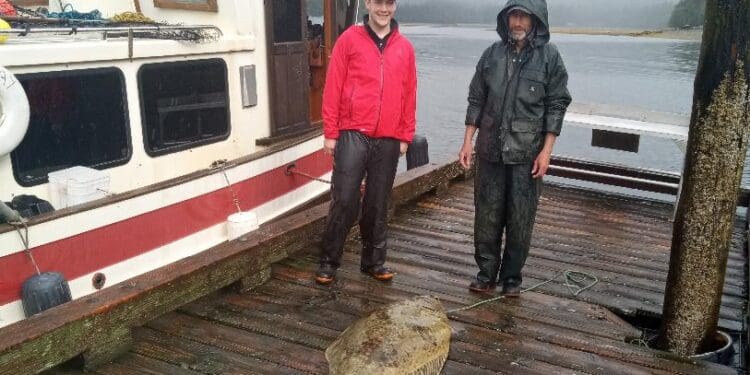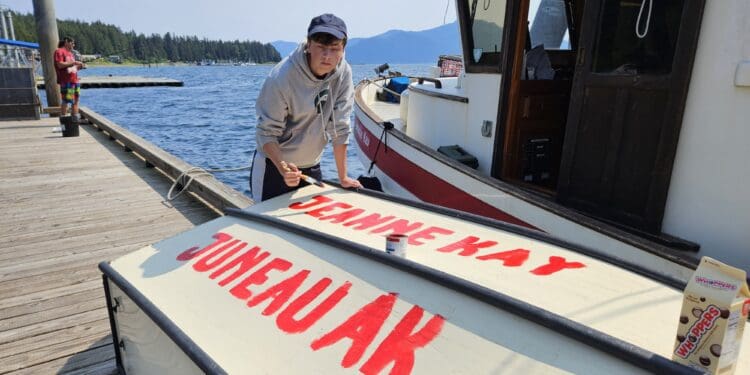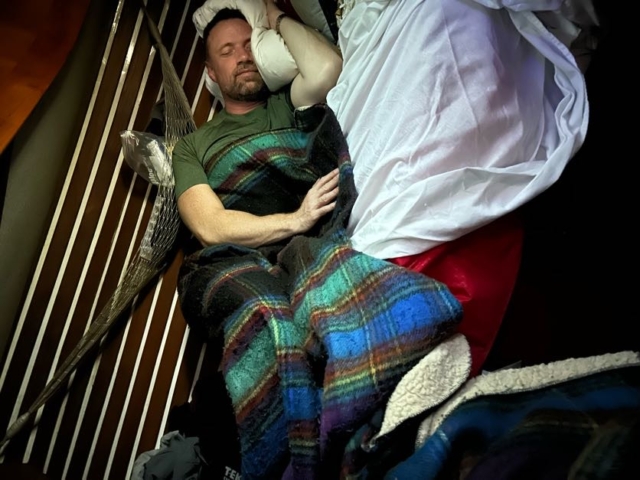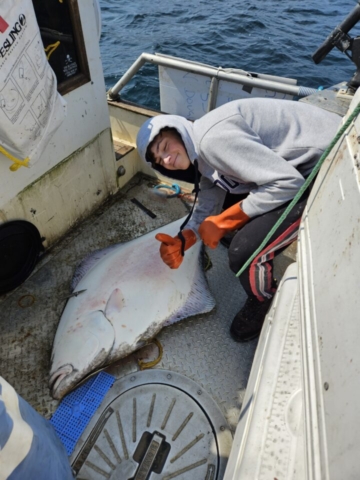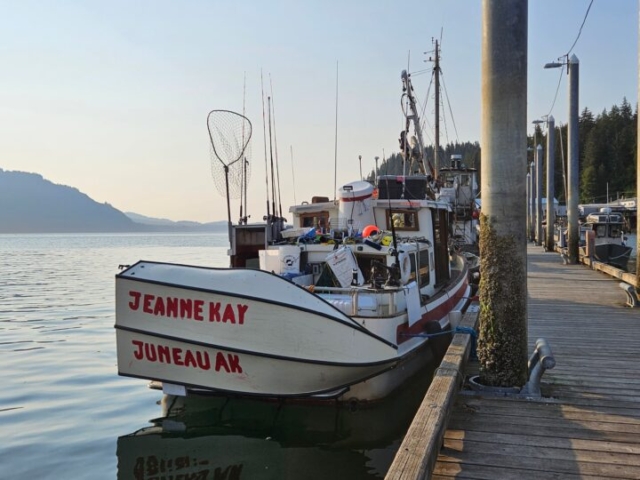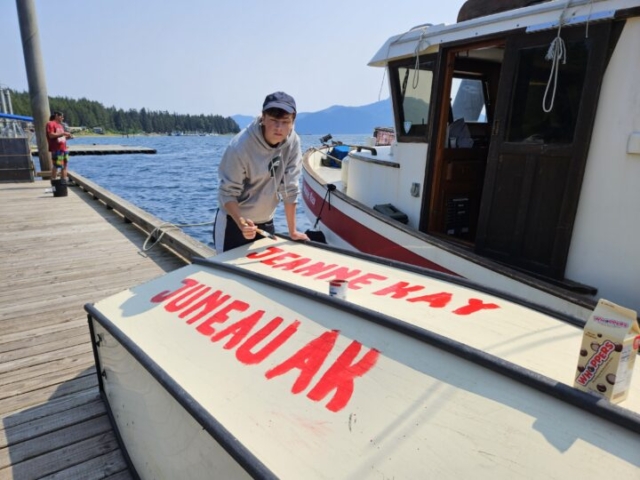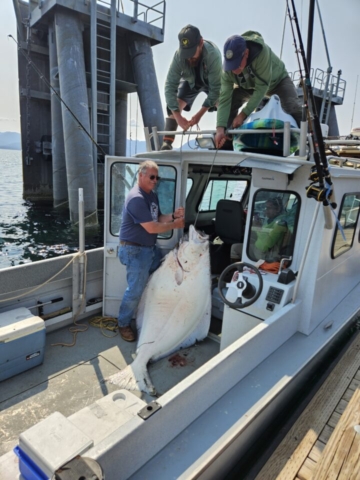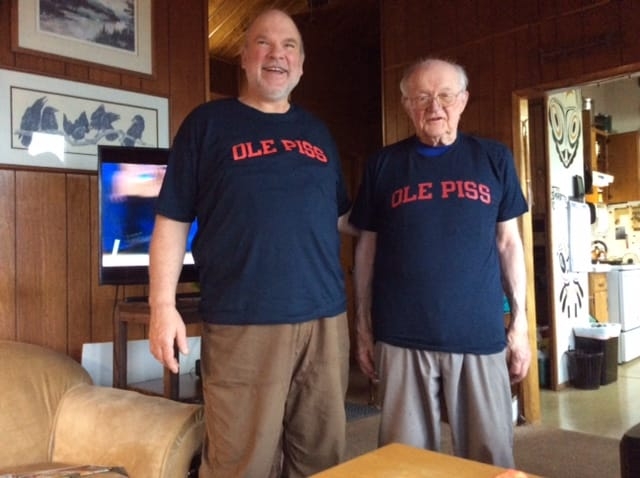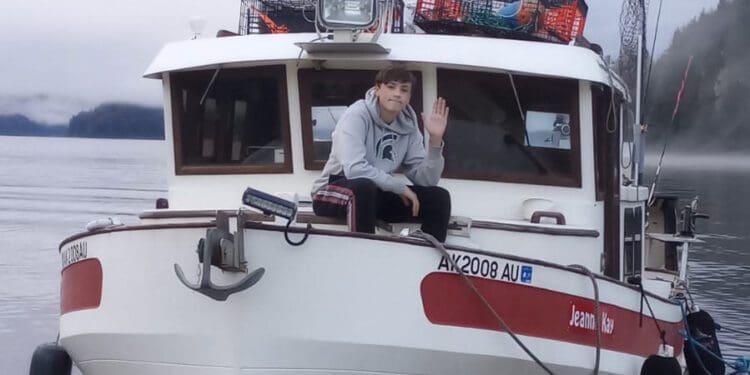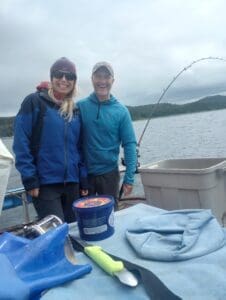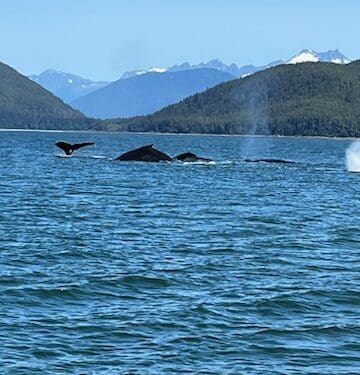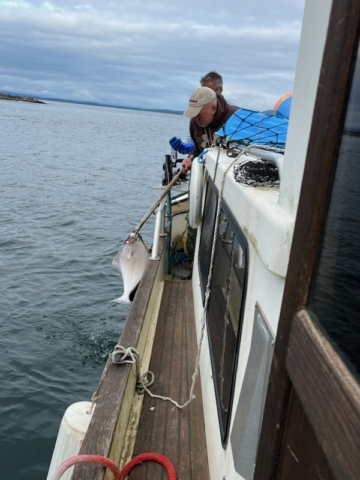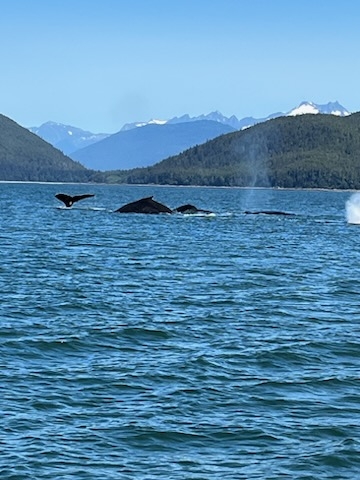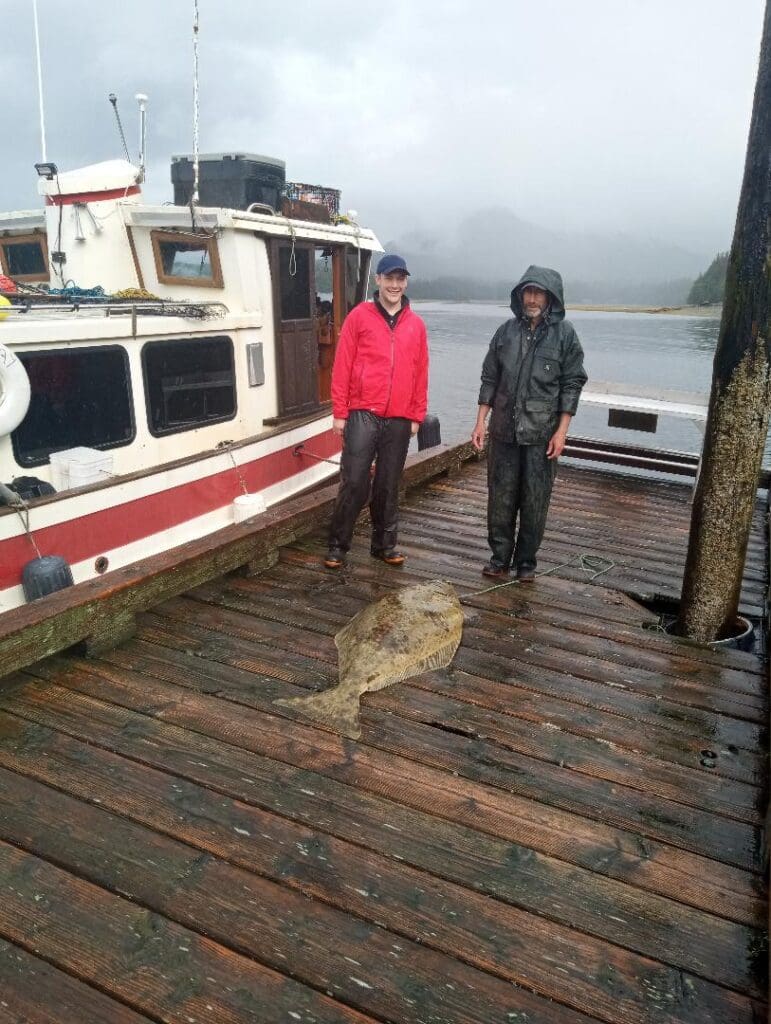
My friend Joe and his son Mathias came fishing this week from Smithers, BC. Both have been here before. The last time when Mathias was about 10, so about 10 years ago. Joe and I trained for the Peace Corps fish farming program together at the University of Oklahoma. He went to Liberia, and I to Sierra Leone for our assignments. All of us who trained together consider each other family.
They drove for two days to get to Skagway, as our current governor has greatly reduced the state ferry system through severe budget cuts, even though the state has 70 billion dollars in the bank, and there is currently no service to Prince Rupert, which is just a four hour drive from Smithers.
They arrived late in the evening, so we slept on the boat and headed out to Point Retreat first thing in the morning. We caught 5 coho trolling down to Funter Bay. I introduced the the men to moose hot links for lunch, and fried salmon frames for dinner. Both were a hit. The boys fished rings off the dock for dungy crab. They caught lots of crab and small fish, but no legal male crab. The owner of the legendary Fugly came by and said the commercial crabbers had blanketed the bay with pots and he’d only eaten crab 4 times all summer. We slept soundly tied up to the Funter Bay dock.
The next morning we had the fishing gear down about 730 am heading out of Funter Bay. We caught no fish all the way to Lizard Head, where we were entertained by a lone seiner closing up their set. Then we caught the first of 6 nice coho trolling on down to the entrance to Hawk Inlet. We picked up the fishing gear at noon, and headed to Freshwater Bay with fair seas. We saw 2 trollers fishing in Iyoukeen Cove, where I’d never fished or seen others fishing, so we put in the gear there. We trolled about half way north up the cove, then turned around as the water was a bit choppy. We lost a nice fish near the point. When we rounded the point, we ran into two big coho. Joe had me teach him how I clean fish, then he taught his son. They cleaned fish the rest of the week. I decided today that will be standard for all my trips. People should clean their own fish if they are going to kill them and eat them, and I can teach them how to do it right. It also gives people more confidence in their abilities. Joe also learned to fillet fish, and he’s better than me at it now. We anchored in Pavlov Harbor.
With a dozen+ fish in the freezer, I thought we’d try for king salmon on day 3. We saw a bear on the beach on the way out of Pavlov Harbor about 7 am, and put the gear down just outside the bay. I changed over from the yellow with red stripe hootchie fished behind small green flashers to king kandy fished alone above little green flashers clipped to the cannon ball eye, and put the gear down deeper. We caught 3 big coho from Pavlov to Wachusett Cove. Normally I keep trolling in the same direction for coho on around East Point, but I turned around and trolled back to Pavlov. Nothing. We turned around again towards Wachusett, and caught 3 more nice coho. This time I kept going. By the time we got to East Point at 10 am, we had 11 nice coho. That would do us for the day. And with 24 fish now in 3 days, that would do us for salmon for the trip. I was glad I had made a few more racks for the freezer to keep the fish separated before they are frozen, as we needed them now. I also learned this trip that the fish in the very center of the freezer don’t freeze very quickly, while the fish to all sides of them towards the 4 walls of the freezer do, so I’ll remember not to place fish on the rack there now.
We processed our catch on the way to Tenakee. We tied up at the short stay dock in Tenakee and walked up to town. Joe looked intently at the warm springs bath house information, including the times for men and women. I walked into the store and was chatting with the owner and others there, reintroducing myself from the trips to Tenakee with Larry. Then Joe walked into the bath house. During the women’s hours. Which he just read. He was immediately harangued by the Tenakee residents in the store, and came right back out. He didn’t get all the way past a wall to where he’d have seen a pile of naked women, but was embarrassed as hell nonetheless. Oh boy.
On the walk to the harbor, I met some Juneau folks, including one of the boys in the scout troop and his parents. The dad had a bag of crab, and I asked him where he caught it. He told me that the spot was across the bay, there were no other pots by his, and that there were so many crab in the pot that he had kept only the biggest of the keepers. He said we were welcome to check his pots on the way out. We were excited to finally find a good crabbing spot.
We headed out about an hour later for the scout family’s crab pots. We never found them. We saw lots of other pots there, so we tried ringing. Caught a keeper the first pull, but only females the rest of the two hours we tried. We had not found the crabbing grounds. Again.
Like last week, the horse flies were horrendous there, so we didn’t stop to try for halibut by Strawberry Island, and headed back around to Pavlov Harbor for the night. The next morning we intended to head back up Chatham towards the cabin I had rented. The forecast was for 10 kt winds in north Chatham Strait, but we were in 2 to 3 foot seas right out of Pavlov. We turned around and decided to go try fishing out of the wind behind Cedar Island. We got back there, and it was a nice little anchorage. We ran up into 10 feet or less of water looking around – the marine chart on my garmin plotter is not at all accurate in this little area – and we were lucky not to go aground. I backed up in time, and we moved into a 70 foot deep bowl, where we fished for an hour or two. As the tide fell, a whole sandy reef was exposed where we almost went aground. Wow. We were lucky. We caught nothing – not even a bite – and I think it was a mud bottom so not a good halibut spot. Surprisingly, the wind laid down, so we ran across Freshwater Bay to the spot John caught his big halibut last week. We saw a little brown bear on Cedar Island as we left. Seemed too small to not have a sow around, but we didn’t see another bear with it.
I had the boys fishing the halibut rods, and I put a jig on a salmon rod for rockfish. I caught one quillback rockfish after another. I kept my limit of 1 – which just seems absurd since there is so little meat on a rockfish that what are you going to do with just one. I released the rest using the gizmo that takes the fish back down to the bottom and releases it so it doesn’t die from the bends. That IS a good regulation. You may wonder why I kept fishing when I had my limit for quillback, and that’s because when I was there with John and Eaton last week, I caught mostly dusky rockfish, and for that species the limit is 5, and I was hoping to start catching them, but never did.
The wind continued to lay down, but there was a blow coming tonight. The boys hadn’t caught any halibut, so I decided to pick up and try to cross Chatham while the seas weren’t too rough.
When we got out to Chatham Strait, it was nice. The calm before the storm. We kept going to cross to the Admiralty shore, where there are numerous bays to get out of the weather if it comes up. I fished the shoreline during my years of power trolling, and it was my favorite area to fish in the spring. I just saw my friend Harry the other day in the store in Juneau. He lived in Angoon at the time and showed me how to fish the area and where to anchor.
We got to the other side, then headed north. Now we were going with the southeast wind and the tide. We kept on going up to Funter Bay to hide for the blow. We made over 8 knots much of the trip, and that’s the fastest I’ve gone in the tug at it’s normal 2750 rpm cruising speed.
We arrived at Funter Bay, and set the 2 hook skate in the same spot as I did with Todd and Renee. Then continued on to the dock, where there was just one other occupied vessel. It was a good feeling to be tied up with a blow coming. And nice that the state DNR that oversees the recreational cabin program allows people to get a credit if they can’t use the cabin for the night they reserved it due to weather. I didn’t want to use the cabin as I saw the boat drag with a much less wind than was forecast for tonight when Todd and Renee and I stayed there. The blow came overnight, but passed through and it was flat calm in the morning.
Joe wanted to try for halibut again. We were heading to town today, so didn’t have a fish storage concern. We had jugs of ice in the freezer that would keep any fish cool til we got to town. We headed towards the skate buoy, and I noticed as we approached that it seemed to have moved some. Possibly a good sign. I readied the harpoon and gaffs. Joe idled the boat up and I hooked the buoy line. There was definitely weight on the line. Then the line started pulling back. Definitely a good sign. Like the last time here, up came the anchors and one of the two hooks in a tangle with a loop still down in the water with the other hook. And this time, a big fish.
I cautiously worked the line up into the boat. I’ve heard of people getting big nurse sharks on their halibut sets, so we didn’t know just what it was till we saw the mottled brown top skin of a big flatfish below. We had a nice halibut. I got the halibut to the surface, and made a clean strike through the head with the harpoon. The harpoon tip toggled on the otherside, and the fish ran. I payed out harpoon line, not wanting the fish to run freely with a bunch of slack line and then break the line when it snapped tight at the cleat like my friends had happen with a 200 lb halibut. I slowly played the fish back up to the side of the boat. Mathias handed me the troll gaff so I could bonk the fish on the head, which I did. Then I cut the gill to bleed it in the water. The fish didn’t thrash much after this. I tied a lasso around the tail and tied the other end of the line to the rail. We had it.
After the fish bled out, Mathias and I both stuck gaffs into the head and together heaved the fish up and over the rail. It was bigger than I thought. We measured the fish at 61 inches, which translated to 115 lbs using the length weight table in the tide book. We headed back to the dock to fillet the fish.
I lined Joe out on filleting a halibut. When he’d finished, he’d done a better job than I can on his first try. We headed to Juneau to process the halibut on fair seas. We saw the usual humpback whales in Saginaw Channel on the way in. What a trip.

